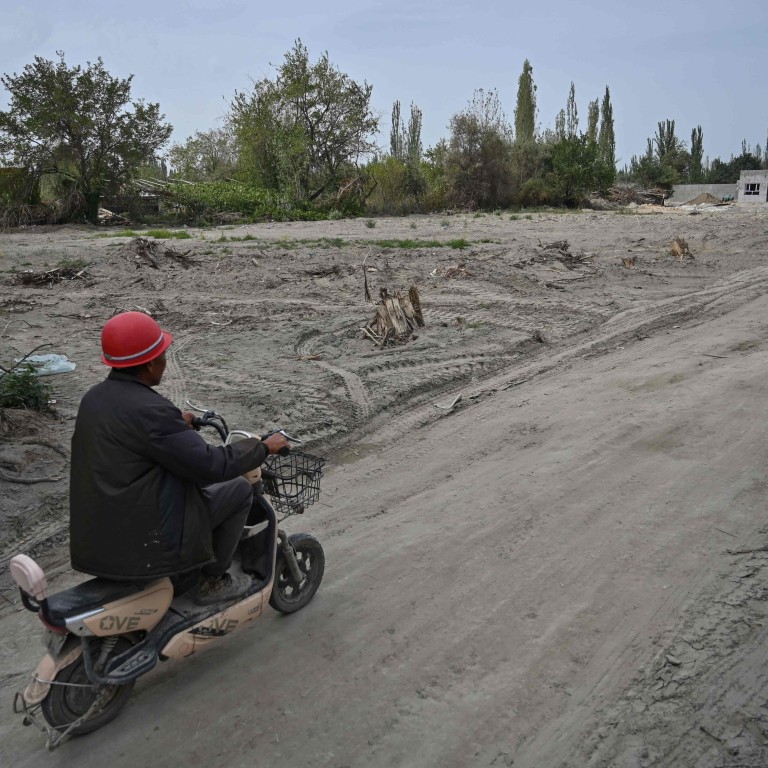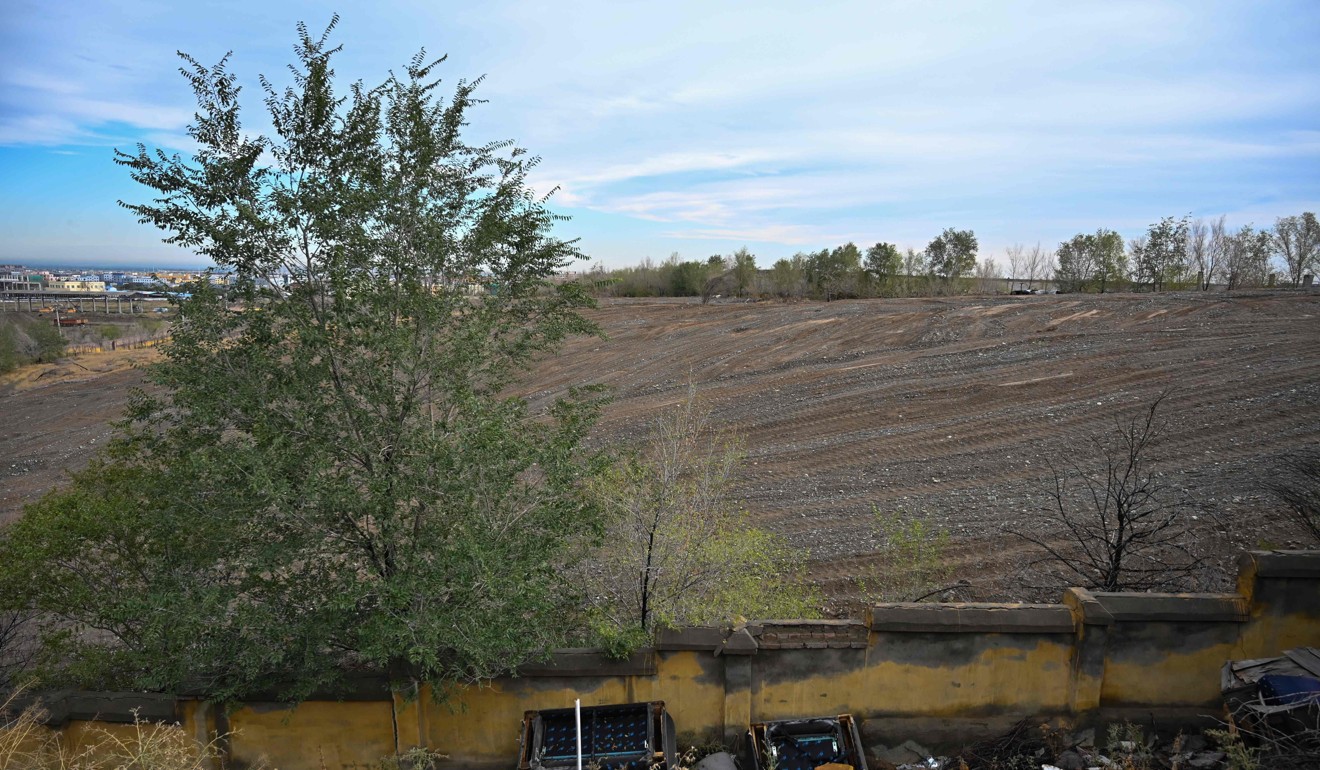
‘No space to mourn’: the destruction of Uygur graveyards in Xinjiang
- Dozens of burial grounds have been cleared in the autonomous region in China’s far west in the last few years, according to a joint investigation
- Official explanations vary but activists say the efforts are part of a push to erode the ethnic group’s identity
Authorities in Xinjiang in China’s northwest are destroying burial grounds where generations of Uygur families have been laid to rest, leaving behind human bones and broken tombs in what activists call an effort to eradicate the ethnic group’s identity.
In just two years, dozens of cemeteries have been destroyed in the region, according to an AFP investigation with satellite imagery analysts Earthrise Alliance.
The analysis indicates that the government has exhumed and flattened at least 45 Uygur cemeteries since 2014 – 30 of them in the past two years.
And in September, AFP visited 13 destroyed cemeteries across four cities and saw bones in at least three sites.
The Xinjiang government did not respond to a request for comment.
The official explanation for cemetery removal or relocation varies by site.
In Urumqi, the regional capital, a cemetery near the international airport was cleared to make way for an urban “reconstruction” project.
US imposes visa restrictions on Chinese officials over ‘brutal suppression’ of Uygurs and other Muslims in Xinjiang, citing ‘internment camps’
To southwest in Shayar, where the local government has built new cemeteries near some of the old sites, an official said the programme was aimed at “standardisation”.
A sign by a new cemetery in the county, which replaced a graveyard from the 18th century containing about 7,500 graves, said the rebuilt sites “saved space, protected the ecosystem” and were “civilised”.
“The new cemeteries are standardised, clean, and they’re convenient for residents,” Kadier Kasimu, deputy director of Shayar’s cultural affairs bureau, said.
But some of the graves were cleared with little care – during a trip in September AFP reporters found unearthed human bones discarded at three sites and tombs reduced to mounds of bricks at others.
Local officials dismissed the evidence – one even picked up a bone, held it next to his right shin, and declared it “too big to be human”.
But seven forensic anthropologists who saw images taken by AFP identified a number of human remains, including a femur, feet, hand bones, and part of an elbow.
“There are a range of ages,” said Xanthe Mallett, a criminologist at the University of Newcastle.
The Shayar government did not respond to AFP’s questions on the process of moving remains to new sites.

In Hotan, southern Xinjiang, residents were given just two days to claim their dead, according to a government notice photographed by AFP in May.
“Any tombstone that was not claimed during the registration period will be relocated as an unclaimed corpse,” it read in Uygur. “The owner of the tombstone is solely responsible for any consequences coming out of the failure in registration.”
Tamar Mayer, a professor of geosciences at Middlebury College, who researches Uygur shrines and cemeteries, described the new sites as homogenous and tightly packed.
Families, which traditionally leave gifts by the graves, no longer had “space to mourn”, she said, adding the policy seemed to be an attempt to “sanitise the area from Uygurs”.
Aziz Isa Elkun, a Uygur activist in Britain whose father was buried in one of the many destroyed cemeteries in Shayar, agreed: “If you want to build new graves then you can, but you do not need to destroy the old ones.”
Jailed Uygur dissident Ilham Tohti wins top European human rights prize
The move to raze Uygur cemeteries is not new – satellite imagery reviewed by AFP shows destruction from more than a decade ago.
But while Uygurs and ethnic minorities were still exempt from certain policies like cremation, which goes against Islamic tradition, authorities appeared to be hardening their stance, said Rian Thum, a Uygur history and culture expert at the University of Nottingham.
They used to have a “non-confrontational approach to Uygur culture, but now any policy that attacks Uygur culture seems to get a boost rather than put in check as their approach has changed”, Thum said.
The security crackdown in Xinjiang had also made it easier for authorities to ram through policies, said Tahir Hamut, a Uygur poet in the United States who left Xinjiang in 2017.
“No one dares to speak up now,” he said “No one raises demands with the government.”
Salih Hudayar, a Uygur living overseas, said the graveyard where his great-grandparents were buried was demolished.
“This is all part of China’s campaign to effectively eradicate any evidence of who we are, to effectively make us like the Han [majority],” he said. “That’s why they’re destroying all of these historical sites, these cemeteries, to disconnect us from our history, from our fathers and our ancestors.”
China slams US ‘lies’ about treatment of Uygurs in Xinjiang region
An estimated one million mostly Muslim ethnic minorities have been rounded up into re-education camps in Xinjiang in the name of combating religious extremism and separatism.
China says the camps are “vocational education and training centres” that offer a benign alternative to formal prosecution for people “influenced by religious extremism”.
Those who are free are subject to rigorous surveillance and restrictions – from home visits from officials to bans on beards and veils.
China has remained defiant despite escalating global criticism of its treatment of Uygurs. This week, the United States said it would curb visas for officials over the alleged abuses and blacklisted 28 Chinese firms it accuses of rights violations.
The destruction was “not just about religious persecution”, said Nurgul Sawut, who has five generations of family buried in Yengisar in southwestern Xinjiang.
“It is much deeper than that,” said Sawut, who now lives in Australia and last visited Xinjiang in 2016 to attend her father’s funeral.
“If you destroy that cemetery … you’re uprooting whoever’s on that land, whoever’s connected to that land,” she explained.

Even sites featuring shrines or the tombs of famous individuals were not spared.
In Aksu, local authorities turned an enormous graveyard where prominent Uygur poet Lutpulla Mutellip was buried into “Happiness Park”, with fake pandas, a children’s ride, and an artificial lake.
Mutellip’s grave was like “a modern day shrine for most nationalist Uygurs, patriotic Uygurs,” recalled Ilshat Kokbore, who visited the tomb in the early 1990s and now lives in the US.
The Happiness Park project saw graves moved to a new cemetery in an industrial zone out in the desert. The caretaker there said he had no knowledge of the fate of Mutellip’s remains.
The Aksu government could not be reached for comment.
In China, urban growth and economic development has laid waste to innumerable cultural and historic sites, from traditional hutong neighbourhoods in Beijing to segments of Dali’s ancient city wall in southwestern Yunnan province. It is an issue Beijing itself has acknowledged.
The government has also been criticised for its irreverence towards burial traditions outside Xinjiang, including the destruction of coffins in the eastern province of Jiangxi last year to force locals to cremate.
But activists and scholars say the clearances are especially egregious in Xinjiang, where they parallel the erasure of other cultural and spiritual sites – including at least 30 mosques and religious sites since 2017, an AFP investigation found in June.
“The destruction of the graveyards is very much part of the wider raft of policies that are going on,” said Rachel Harris, who researches Uygur culture at the School of Oriental and African Studies at the University of London.
“From the destruction of holy shrines, the tombs of saints, to the destruction of tombs of families, all of this is disrupting the relationship between people and their history, and the relationship between the people and the land that they live on.”

.png?itok=arIb17P0)